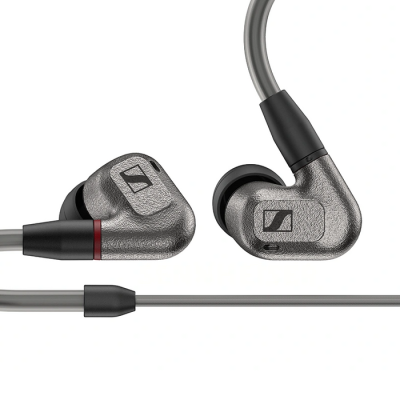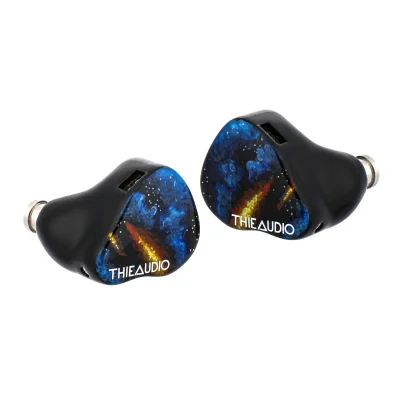Sennheiser IE600 and Thieaudio Origin use 1DD and 1DD+4BA+2EST+1BC driver setups respectively. Sennheiser IE600 costs $700 while Thieaudio Origin costs $849. Thieaudio Origin is $149 more expensive. Thieaudio Origin holds a clear 0.5-point edge in reviewer scores (7.5 vs 7.9). Thieaudio Origin has significantly better bass with a 1.8-point edge, Thieaudio Origin has significantly better mids with a 1.5-point edge, Thieaudio Origin has significantly better dynamics with a 2.5-point edge and Thieaudio Origin has better soundstage with a 0.8-point edge.
Insights
| Metric | Sennheiser IE600 | Thieaudio Origin |
|---|---|---|
| Bass | 7.3 | 9 |
| Mids | 6.5 | 8 |
| Treble | 6.4 | 6.5 |
| Details | 7 | 7.9 |
| Soundstage | 7.3 | 8 |
| Imaging | 6.5 | 7.9 |
| Dynamics | 6.5 | 9 |
| Tonality | 6.9 | 8.1 |
| Technicalities | 7.3 | 7 |
Sennheiser IE600 Aggregated Review Score
Average Reviewer Scores
Average Reviewer Score:
7.5Generally Favorable
Thieaudio Origin Aggregated Review Score
Average Reviewer Scores
Average Reviewer Score:
7.9Strongly Favorable
Reviews Comparison
Sennheiser IE600 reviewed by Super* Review
Youtube Video Summary
$700 buys a compact, 3D-printed metal single-DD that looks mature and fits like a glove. The IE 600 arrives with two cables (3.5mm and 4.4mm) that are thin and comfy but a bit microphonic thanks to stiff, moldable ear hooks. Connectivity is MMCX, yet Sennheiser’s slightly non-standard recess limits third-party cable options. Isolation is a touch below average, but the tiny shells seat past the tragus, stay secure, and even work as a sleeping IEM. The real facepalm is the stock tips—especially the silicone set with collapsing walls. Foam tips are usable (and subtly affect treble), but the easiest fix is Final E-type tips, which keep the incisiveness while curbing sibilance better than Moondrop Spring Tips.
Tonally, think tasteful V-shape: a sub-bass-weighted low end with just enough mid-bass wallop for body, natural and appropriately forward mids, and spicy, well-extended treble. The draw is the technical ride—top-to-bottom texture, punch, and an almost visceral snap. Bass is a standout: deep, delineated rumble that doesn’t smear the mids yet feels physical on everything from EDM to Fleetwood Mac. Treble gives cymbals real weight and timbre (a spot where many sets thin out), while stage is bigger than average with solid imaging—cohesive rather than gimmicky holography. Compared side-by-side, it’s bolder and more contrasty than a warm-neutral Zen Pro, and far more physical than the airy, sterile-leaning Moondrop S8, yet it keeps vocals clean and convincing.
Quibbles exist—awful stock tips, a touch of treble bite depending on fit, and that picky MMCX—but the core experience is special. With a quick tip swap, IE 600 delivers endgame-within-reach performance: exhilarating bass quality, incisive treble, natural mids, comfort for hours, and virtually no deal-breaking caveats. At $700 it’s not cheap, but it competes fearlessly with far pricier IEMs and feels like a set to buy once and be done.
Super* Review original ranking
Super* Review Youtube ChannelBuy Sennheiser IE600 on HiFiGO
Ad
Price: $699
Buy Sennheiser IE600 on HiFiGO
Thieaudio Origin reviewed by Super* Review
Youtube Video Summary
At $850, Thieaudio Origin positions itself as an unapologetic bass icon with a complex driver stack (1DD/4BA/2EST plus bone conduction). Build and accessories are a mixed bag: the large, chunky shells will be too big for many ears, and the semi-transparent, pattern-heavy faceplates feel a bit generic. The thick stock cable suits the heft but the swappable plug mechanism is long, doesn’t lock, and often detaches at the adapter rather than the jack—an unnecessary annoyance. Fit is the major caveat; for smaller ears, contact is mostly at the tip, which compromises comfort and seal consistency.
Sonically, Origin is unmistakably bass-forward—well beyond Harman—with a warm, thick low end that initially reads as overbearing and soft on definition. With time, that bass takes on a distinctive, “ooey-gooey” atmospheric quality that sits under the mix rather than congesting it, enabling a surprisingly grand, spacious presentation. Above the lows, the tuning is “new-meta” adjacent: neutral-ish mids, balanced upper-treble, and a touch of mid-treble bite that sharpens transients and adds contrast. The trade-off is occasional edginess/sibilance on certain vocals, but guitars and percussion benefit from extra snap. Live recordings in particular gain scale and drama.
Against the Mega 5 EST Bass+ (cheaper, similarly boosted), Origin offers better separation and more engaging transients, while the Mega feels sludgier and less distinct—though also less edgy. Overall, Origin is a unique bass experience that prioritizes mood and scale over textbook bass tightness. The combination of fit challenges, polarizing low-end quality, and treble bite tempers enthusiasm, settling at a three-star (out of five) verdict—compelling for bass lovers seeking something different, but not a universal recommendation.
Super* Review original ranking
Super* Review Youtube ChannelBuy Thieaudio Origin on Linsoul
Ad
Price: $849
Buy Thieaudio Origin on Linsoul
Sennheiser IE600 reviewed by Jays Audio
Jays Audio Youtube Channel
Thieaudio Origin reviewed by Jays Audio
Youtube Video Summary
Thieaudio Origin takes the “Meta” idea and dials it toward a fuller, bass-forward presentation without losing control. The bone conduction driver is not a gimmick—low notes carry palpable vibration and reverb while staying tight with clean layering and no mid bleed. Vocals sit naturally—neither shouty nor buried—though this isn’t a vocal-focused set (reach for RS5 if that’s the priority). Versus Oracle Mk II, the Origin trades some cleanliness for deeper tactility and weight, making bass textures feel more alive.
The top end is airy and extended on smooth Sonion ESTs, cutting through the warmth to balance the tuning. Most tracks are fine, but snare- and cymbal-heavy songs at higher volumes can push the treble into fatiguing territory (e.g., around 3:30 in Hikaru Utada’s “Time”). It’s generally controlled at moderate levels; just note that treble energy scales and can turn sharp when cranked.
In A/Bs, the Origin’s bass texture outclasses sets like Mega 5 EST, offering more detail, impact, and less boom. Against TITAN, Origin’s reverb and low-end “shake” edge it out while avoiding the Titan’s 5 kHz peak—though Titan still feels more exciting with livelier vocals. Versus all-rounders Monarch Mk II and Hype 10, those remain cleaner with better mids/layering but can’t match Origin’s sheer bass depth. The wildcard is BAJIE: stock, Origin wins; with EQ, BAJIE’s bigger 14.2 mm driver slams harder, while Origin stays the more balanced, tactile choice. Net: for a premium, fun, bass-centric daily driver under a grand, Origin sets a new reference—unless maximum slam with EQ is the goal.
Jays Audio Youtube Channel
Sennheiser IE600 reviewed by Tim Tuned
Youtube Video Summary
Sennheiser IE600 hits with a confidently V-shaped signature: powerful yet tidy bass that thumps with dynamic-driver slam, a flat, clean lower midrange, and lively upper mids that make vocals and instruments pop. Timbre is notably natural—free from plasticky glare—and the treble pushes plenty of sparkle and micro-nuance without tipping into sibilance or fatigue for most listeners. The result is an energetic yet slightly analytical listen, where details jump out, separation stays intact, and the stage opens up with convincing width and a sense of air. Imaging shows near-pinpoint placement with real depth, contributing to a presentation that feels both exciting and controlled.
In A/Bs, IE600 trades blows with mid-fi favorites: versus Moondrop Variations, the Sennheiser is the more resolving and a touch more natural in timbre (Variations projects a wider stage and leans cleaner/U-shaped). Against DUNU SA6, SA6 offers the safer, more reference-leaning tuning, but IE600 pulls ahead on detail, note definition, and stage size. Compared with Thieaudio Oracle, Oracle stays truer-neutral, yet IE600 flexes stronger technical performance—the kind usually reserved for pricier sets, rivaling classics like Clairvoyance and Monarch Mk1. The catch is treble quantity: those sensitive to extra top-end bite may find it a bit much. Everyone else gets a compact, feather-light shell with outstanding comfort, a richly textured low end, vivid mids, and class-leading detail under $1,000—an easy recommendation if an energetic treble tilt fits the taste.
Tim Tuned Youtube Channel
Thieaudio Origin reviewed by Tim Tuned
Sennheiser IE600 reviewed by Jaytiss
Thieaudio Origin reviewed by Jaytiss
Youtube Video Summary
Thieaudio Origin brings a wild driver stack—1 DD + 4 BA + 2 EST + 1 bone conductor—inside a massive yet surprisingly comfortable shell. Build feels premium: striking faceplate, visible bone-conductor puck, proper nozzle lip, and a thicker cable than usual from the brand. The hockey-puck case is a nice touch, and for about $100 more there’s custom artwork available, making the unboxing and ownership experience feel a bit more special.
Sonically, this one swings for impact. Bass hits clean, strong, and fun, with upper mids that come across pristine. The trade-off: a hotter mid/treble band (around the 4–10 kHz region, with a notable 6 kHz glare) that can push cymbals and strings into an unnatural territory. Resolution and imaging don’t always keep pace for the price; stage is big and enveloping, but fine detail and separation can blur, making it a specialist that thrills on bass-centric tracks yet feels less convincing on metal or complex orchestral pieces.
Against its siblings, Origin sits like a more fun, bass-forward take compared with HYPE 4/10, but with a treble execution that’s less refined. Versus Oracle MK3, the latter’s ESTs sound crisper and cleaner; versus Monarch MKIII, that model’s tasteful 5–8 kHz dip lends better resolution. If pure detail is the target, sets like HiSenior Mega5 Bass or the Subtonic Annihilator may prove more satisfying. As a whole, Origin is a unique, bass-thrilled experience with excellent fit, huge space, and customization perks—great for those chasing visceral low-end and a cinematic stage, less ideal for listeners prioritizing treble finesse and microdetail at this tier.
Jaytiss Youtube Channel
Sennheiser IE600 reviewed by Head-Fi.org
Thieaudio Origin reviewed by Head-Fi.org
Sennheiser IE600 (more reviews)
Sennheiser IE600 reviewed by Crin
Youtube Video Summary
Sennheiser’s IE600 reads like a course correction for a storied brand whose IEMs long suffered a 2–5 kHz dip and blunted energy. Here the midrange is finally set straight—no weird upper-mid recession, just natural, well-placed mids with proper presence. The single dynamic driver is tuned with uncommon discipline: a sub-bass-focused shelf that brings power and tactility without bleed, staying tight and controlled where past models went mushy.
The twist is the treble: an emphasis around 9–10 kHz that can split listeners. For some, that edge will read as sibilant; for others, it’s the rare, airy sparkle that makes cymbals and transients feel alive—call it the “blue cheese” effect. Technical chops are no afterthought either; resolution sits shoulder-to-shoulder with the IE900, trading blows with heavy hitters like Softears Turii, Dunu Luna, and JVC HA-FW10000, while avoiding their tuning quirks.
Measured against its field, the IE600 delivers A+ tone, A+ technical performance, and at $700 earns serious value credentials—enough to make the pricier IE900 feel hard to justify. In the wake of the Sonova acquisition, this feels like redemption: a market-breaking Sennheiser IEM that gets the fundamentals right, then adds just enough treble audacity to be special.
Crin Youtube Channel
Sennheiser IE600 reviewed by Audionotions
Sennheiser IE600 reviewed by Gizaudio Axel
Gizaudio Axel original ranking
Gizaudio Axel Youtube ChannelSennheiser IE600 reviewed by Shuwa-T
Sennheiser IE600 reviewed by Precogvision
Precogvision Youtube Channel
Sennheiser IE600 reviewed by Nymz
Thieaudio Origin (more reviews)
Thieaudio Origin reviewed by Z-Reviews
Youtube Video Summary
Thieaudio Origin goes full mad-science: 1DD + 4BA + 2EST + bone conductor (eight drivers per side), big shells, hefty stock cable, and a tuning built around a ~12 dB sub-bass shelf. Fit can be a touch chunky, but foam tips (think Render) lock in seal and turn the low end from “more bass somewhere” into deep, anchored slam; silicone leaves it a bit loose. Accessories are barebones—swap plugs, tips, case—and that’s it. No fancy gifts, just a box of sound.
Sonically it’s a deconstructed presentation: instead of one smooth ribbon like a single DD, the Origin spreads the band across space—drivers carving out their lanes so instruments pop up here… then there… then over there. It’s not “mushy blend,” it’s forcible separation that can feel museum-exhibit surreal: treble details flit around (hello ESTs) while bass feels omnipresent and room-filling. It doesn’t really scale with amps; neutral DAC/amps to pricier rigs all keep roughly the same character. What can change the tonality is cable impedance—at 9 Ω and high sensitivity, cheap/high-resistance wires can skew things, so stick with a stout low-impedance lead.
Gripes? The cable is thick, custom faceplates up the bill, and the package isn’t exactly a Santa sack. But for $850, the payoff is a unique, spacious, “pulled-apart” soundstage that turns playlists into set pieces. Not for purists chasing one-driver cohesion; absolutely for listeners who crave clarity, staging theatrics, and tactile bass. Final word: a solid 9/10 on sound and swagger—price keeps it off the throne, excitement keeps it in the cart.
Z-Reviews Youtube Channel
Thieaudio Origin reviewed by
 Fresh Reviews
Fresh Reviews
Youtube Video Summary
Thieaudio Origin steps into the high end with a hybrid array—1DD + 4BA + 2EST + bone conduction—that pushes a richly textured, holographic presentation. The soundstage is wide and deep, imaging snaps into place, and the resolution clears the bar set by mid-tier sets. Most striking is the low-end: sub-bass digs deep with palpable rumble and impact yet avoids flooding the mix, leaving mids clean, detailed, and lifelike, and the treble airy with convincing cymbal sheen. At $850, the overall technical polish and bass quality feel appropriately premium—better than some kilobuck options.
For competitive gaming, the tuning translates across titles with ease. In Valorant, staging, separation, and distance cues deliver an A experience; occasional low-end bloom can introduce slight over/under flicks on sudden off-screen shots, but not often enough to dent performance. In Apex Legends, verticality and imaging impress (A-): during chaotic third/fourth-party fights, some lighter movement cues (slides, climbs) could cut through a bit more. In Warzone, depth and impact enhance immersion without masking key information, keeping imaging and separation strong. Tip rolling helps: foam trims bass and brightens; silicone restores slam.
Build and ergonomics match the sonic ambition: a galactic faceplate, sturdy 2-pin cable with swappable terminations, and a chassis that’s larger than average yet comfortable for long sessions (minor fatigue around the 6-hour mark). The nozzle is wide but short with a solid lip for secure tips. Overall, this is a fun yet precise set that excels in music and earns a high mark on a “wall-hack certified” style tier list for shooters—driven by standout bass, convincing staging, and top-tier separation.
Fresh Reviews original ranking
Fresh Reviews Youtube ChannelThieaudio Origin reviewed by Web Search
The Thieaudio Origin delivers a bass-forward signature with a substantial 12dB sub-bass boost that provides visceral rumble and slam, particularly effective for electronic or hip-hop genres. Despite this emphasis, the neutral midrange avoids bloat, preserving vocal clarity and instrument separation, while the electrostatic drivers contribute a smooth, airy treble free from harshness or sibilance. Its technical performance is strong, offering a wide, holographic stage and precise imaging, though micro-detail retrieval falls slightly short of some competitors in its price tier.
Comfort is divisive due to the large shells, which may cause fatigue or fit issues for those with smaller ears, necessitating careful tip selection for optimal seal. The package includes a high-quality modular cable with swappable terminations (3.5mm/4.4mm) and a distinctive round Alcantara case, though the included ear tips may not suit all users.
Sennheiser IE600 Details
Driver Configuration: 1DD
Tuning Type: V-Shaped
Brand: Sennheiser Top Sennheiser IEMs
Price (Msrp): $700
Support our free service! Buying through our affiliate links costs you nothing extra:
Thieaudio Origin Details
Driver Configuration: 1DD+4BA+2EST+1BC
Tuning Type: Neutral with Bass Boost, Basshead
Brand: ThieAudio Top ThieAudio IEMs
Price (Msrp): $849
Support our free service! Buying through our affiliate links costs you nothing extra:
Sennheiser IE600 User Review Score
Average User Scores
Average User Score: n/a
Based on 0 user reviews
No user reviews yet. Be the first one who writes a review!
Thieaudio Origin User Review Score
Average User Scores
Average User Score: n/a
Based on 0 user reviews
No user reviews yet. Be the first one who writes a review!
Sennheiser IE600 Gaming Score

Gaming Score & Grade
- The gaming score is prioritizing technical capabilities of the IEM (Separation, Layering, Soundstage) and good value.
Gaming Score
6.7Gaming Grade
B+Thieaudio Origin Gaming Score

Gaming Score & Grade
- The gaming score is prioritizing technical capabilities of the IEM (Separation, Layering, Soundstage) and good value.
Gaming Score
7Gaming Grade
A-Sennheiser IE600 Scorings
Average Technical & Tuning Grades
Average Tunign Grade
B+- The tuning leans easygoing, yet occasional unevenness nudges it away from greatness. A bit of EQ polish can smooth things nicely.
Average Technical Grade
A-- It manages detail and layering well enough, even if the stage feels only moderately sized. You get a clear sense of left and right, if not depth.
Thieaudio Origin Scorings
Average Technical & Tuning Grades
Average Tunign Grade
A+- Tuning feels refined, blending frequencies with convincing realism and engagement. Transitions between registers feel effortless.
Average Technical Grade
A-- The presentation feels orderly, balancing workable detail retrieval with acceptable imaging cues. It keeps momentum without smearing transients.
Sennheiser IE600 User Reviews
"This is an example review"
Pros
- Example pro 1
- Example pro 2
Cons
- Example con 1
- Example con 2
Share your experience and build your personal ranking list.
You need to be signed in to write your own reviewThieaudio Origin User Reviews
"This is an example review"
Pros
- Example pro 1
- Example pro 2
Cons
- Example con 1
- Example con 2
Share your experience and build your personal ranking list.
You need to be signed in to write your own reviewFind your next IEM:
IEM Finder Quiz
newIEM Comparison Tool
newVS




























